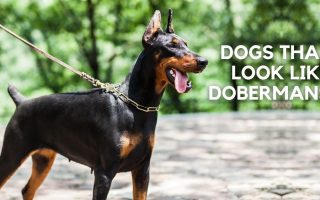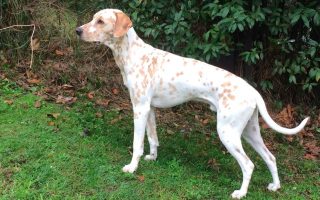When people talk about Huskies, they often refer to the Siberian Husky.
Like a sibling that hides in the shadow of her prettier sister, the Alaskan Husky doesn’t get the attention it deserves.
Even the American Kennel Club doesn’t recognize it as a breed of its own.
What makes the Alaskan Husky even more invisible is the close resemblance it shares with the Siberian Husky.
At first glance, they look like they belong to the same breed. We can imagine many Alaskan Husky owners out there having to explain why their pooch is not an odd-looking Siberian Husky or a Siberian Husky mix.
On Alaskan Husky vs Siberian Husky, both breeds do have a lot in common, and they are even related, but they also have the peculiarities that make them unique.
This article will draw out the similarities and differences of both types of huskies.
Alaskan Husky Vs Siberian Husky: General Facts
| Facts | Alaskan Husky | Siberian Husky |
|---|---|---|
| Height | 20 to 26 inches | 20 to 23 inches |
| Weight | 38 to 50 pounds | 35 to 60 pounds |
| Coat Type | Double | Double |
| Coat Colors | Black, white | Black, white, tan, red |
| Temperament | Energetic, alert, protective | Friendly, energetic, intelligent |
| Trainability | Medium | Medium |
| Life Expectancy | 10 to 15 years | 10 to 15 years |
| Energy | High | High |
| Good First-Time Dogs | No | No |
| Good with Kids | Yes | Yes |
| Good for Apartments | No | No |
| Good for Family | Yes | Yes |
| Shedding | Yes | Yes |
| Barking/Howling | High | High |
Alaskan Husky Dog Breed Overview
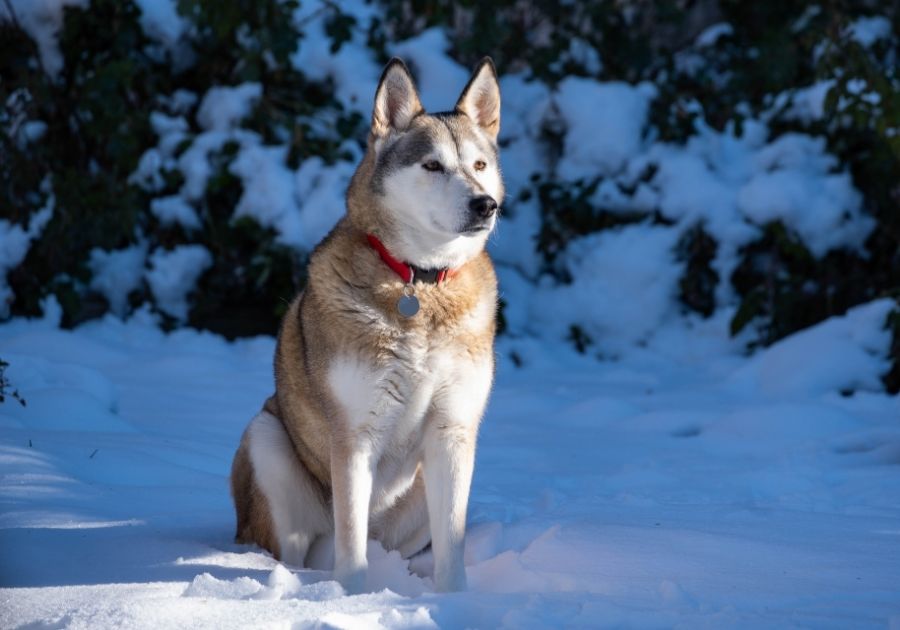
Alaskan Husky History
Because it is recognized more like a type than a breed, the Alaskan Husky is relatively rare.
There is little information on it, but what we do know is that the Alaskan Husky originated in Alaska.
It is a descendant of the Siberian Husky, the German Shepherd, the Border Collie, and the Inuit Husky. The breed was developed to pull sleds and it did its job well.
These days, the Alaskan Husky can be found sled racing. It is not recognized by any Kennel Club as a purebred.
Alaskan Husky Appearance
Because it isn’t a recognized pure breed, the appearance of each Alaskan Husky dog differs significantly.
However, there are some common traits. They all have the wolflike looks sled dogs commonly have, complete with erect ears.
In size, the Alaskan Husky is medium-sized. It usually weighs between 38 and 50 pounds, with a height that falls between 20 and 26 inches.
The coat is always double, and it usually comes in either black or white.
Alaskan Husky Personality
Alaskan Huskies are pack dogs, just like other sled dogs. They fit well in a multiple dog household for this reason.
They are team players, so you can count on this breed to co-operate with both man and canine.
In addition to being cooperative, the Alaskan Husky is also friendly. It loves being around people and you might find it snuggling up to you.
It enjoys being indoors and around family, but it needs to be outdoors too. For this reason, it makes a poor apartment dog.
Bear in mind that the Alaskan Husky is highly energetic and won’t be content with a simple walk around the neighborhood.
It needs to be well exercised and regularly. This breed loves having something to do.
The Alaskan Husky is trainable, but it is not an easy task.
Because of its high energy and independent spirit, the first-timer is not advised to own one.
Siberian Husky Dob Breed Overview
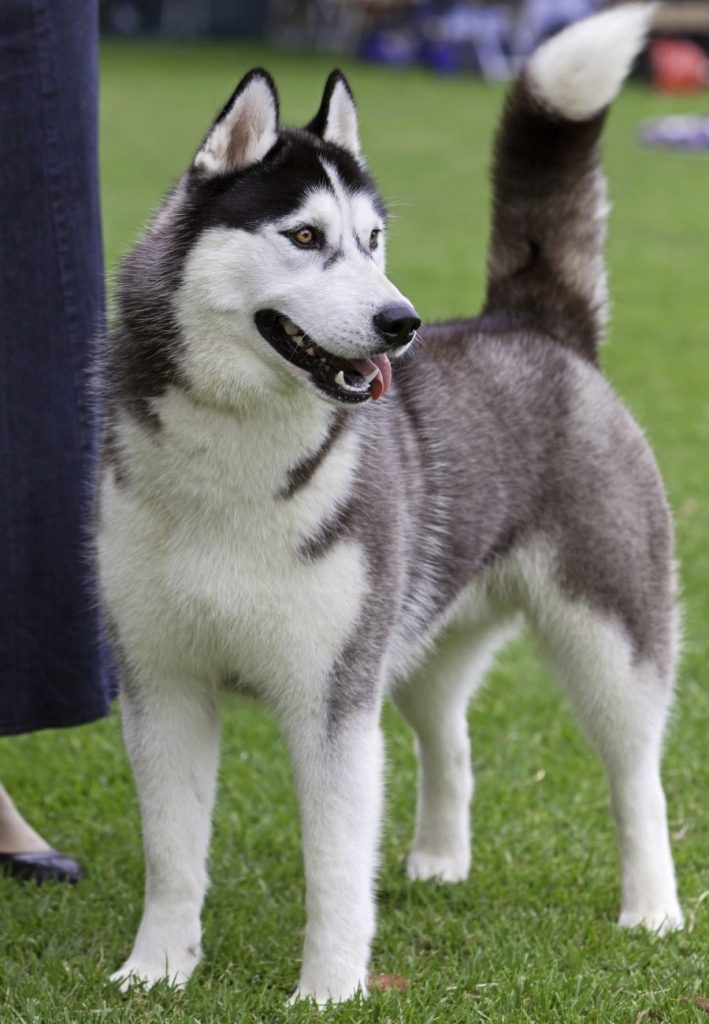
Siberian Husky History
The Siberian Husky did go into Alaska during the gold rush of 1908 and was instrumental in the breeding of the Alaskan Husky.
Before then, it was the sled dog and companion of the Chukchi tribe in Siberia.
These dogs pull sleds in the morning, then acted as companions in the evening.
By 1930, the Siberian Husky was completely out of Siberia and began to evolve to what we know today.
The same year, the American Kennel Club recognized this breed. 8 years later, the Siberian Club of America was formed.
Siberian Husky Appearance
The Siberian Husky is the breed that first comes to mind when people think of a domesticated wolf.
Though smaller in size than the wilder animal, the Siberian Husky has the same erect ears, fierce looks, and canine as the wolf. The Siberian Husky even howls.
It is a medium-sized breed that weighs between 35 and 60 pounds and grows to a height of 20 to 23 inches.
It has a double coat that helped it survive in the cold Siberian region, and it tends to shed.
Aside from the Agouti Husky, Siberian Huskies come in different colors, including black, white, tan, and red.
Siberian Husky Personality
The Siberian Husky is one of the most popular dog breeds in the United States, and while the major reason for this is its striking looks, don’t scrape off its personality.
An extroverted dog, this breed is willing to be everyone’s friend and hardly makes an enemy.
The only security it can bring is scaring an intruder away. Besides that, the Husky makes a poor guard dog.
It is a good companion, though, just like in its Chukchi days. This breed loves people, especially those it sees as members of the same pack.
The only challenges you might face are their energetic nature and independence.
The Husky is not for the laid-back or the couch potato. It needs an active owner. It is also not suitable for a new pet parent.
Many first-timers make the mistake of getting a Siberian Husky because of its looks, then get frustrated when they find they can’t handle the breed’s independent spirit.
Training is best undertaken by an experienced owner.
Alaskan Husky Vs Siberian Husky: Differences & Similarities
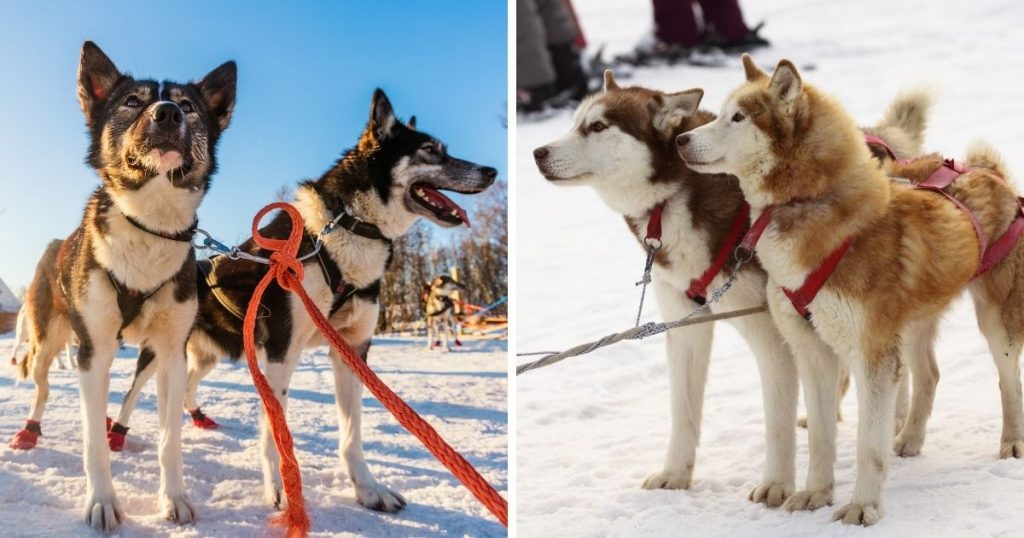
From the sections above, it does feel like we’re talking about two versions of the same breed. However, that is not the case.
Let us figure out the differences between both amidst the haystack of similarities.
Alaskan Husky vs Siberian Husky Size
The Siberian Husky and the Alaskan Husky have the same body shape and physical structure, but that’s where the physical similarities end.
The Alaskan Husky tends to be smaller in weight and height when compared to the Siberian Husky. It is also leaner and longer than its Siberian relative.
Energy
Both dogs are known to be highly energetic and require the same amount of exercise daily. You shouldn’t own one without giving it the appropriate amount of exercise.
As much as they can cope indoors, they love staying outdoors as well. It is best to have either one in a house with a fenced yard.
Caution should be taken during summer, however, as both dogs will get exhausted easily under the heat.
Some playtime in a fenced yard can help them release pent-up energy. When the weather is cooler, they make good jogging buddies and might even be down for a hike.
Alaskan Husky vs Siberian Husky Temperament
You’d be hard-pressed to find any difference in the personalities of both breeds as they act the same.
Siberian Huskies are just as friendly and affectionate as Alaskan Huskies.
Without sufficient information on the Alaskan Husky, it is hard to draw any line in their personalities. We can safely assume that there are none.
Trainability
Both breeds are trainable and can be domesticated, but training doesn’t come easily for either. The ideal owner should be firm, patient, and consistent with training.
There’s a lot to suggest that the Siberian Husky might be easier to train compared to the Alaskan Husky because the former has been a companion since history. However, that would be speculation.
Whether you own a Siberian or Alaskan Husky, the same principles apply. Start by establishing a hierarchy so they can see you as leader of the pack.
Be sure to train these dogs when you’re in the right state of mind so you can remain calm.
Avoid getting angry and using punitive methods on these dogs. Instead, encourage them with positive reinforcements.
Health Problems and Life Expectancy
Both the Alaskan and Siberian Husky has the same life expectancy of 10 to 15 years.
That’s longer than many breeds out there, but it doesn’t mean they won’t fall ill.
Because of its purebred status, the Siberian Husky is usually more at risk of illness than the Alaskan Husky.
Some illnesses that can affect the Alaskan Husky include progressive retinal atrophy, hypothyroidism, and lysosomal storage disease.
Progressive Retinal Atrophy (PRA) is an eye condition that is caused by a gradual deterioration of the retina and eventually leads to blindness.
Hypothyroidism is caused by a lack of thyroid hormone. Lysosomal storage disease occurs when the dog’s body lacks the enzyme that breaks down glycogen in the liver and muscles.
The Siberian Husky’s major problems are hip dysplasia and some eye issues like Corneal Dystrophy, Cataracts, and also Progressive Retinal Atrophy.
Origin
Here the difference is clear, but there’s still an overlap that you already know. The Siberian Husky originated in Siberia while the Alaskan Husky was formed in Alaska.
The overlap is on the subject of ancestry. The Siberian Husky was amongst the dogs used to create the Alaskan Husky.
Eye Color
One major difference between the Siberian Husky and the Alaskan Husky is the eye color.
The Alaskan Husky has just one eye color, which is a clear brown. The Siberian Husky, however, has both brown and blue eye colors.
Coat Type and Grooming
Both breeds have the same coat type (double and thick) but they don’t come in the same colors.
There is nothing too spectacular about the Alaskan Husky’s coat and it comes mainly in black and white (with some occasional orange mark).
The Siberian Husky’s coat is more striking as it comes in a variety of colors like tan, red, black, and white. The latter also has long hair.
Grooming both breeds is easy, but the Siberian Husky’s coat takes more effort than the Alaskan Husky.
They are both shedders and need to be brushed regularly, bathed now and then, alongside other hygiene habits.
Breeding Purpose
One reason why the Alaskan Husky looks too simple is that it was bred solely for work without much attention being paid to its looks.
Even now, it is more of a worker than a companion. This isn’t the case for the Siberian Husky that started as both a worker and a companion.
These days, it is more of a companion than a worker.
Siberian Husky vs Alaskan Husky Popularity and Kennel Club Recognition
The Siberian Husky is a very popular dog breed, so much that the Alaskan Husky might be mistaken for the former, not the other way round.
After its recognition by the American Kennel Club in 1930, it slowly rose to fame.
The global success of the TV show Game of Thrones increased demand for it.
While not as popular as the German Shepherd, Labrador Retriever and Golden Retriever, the Siberian Husky is easily recognizable.
In contrast, the Alaskan Husky is rare and not recognized by any major kennel club.
This is because there is no fixed standard for looks as the Alaskan Husky wasn’t bred with looks in mind.
Price

Due to its rarity, the Alaskan Husky is not easily found and tends to be more expensive than the Siberian Husky puppy.
The Alaskan Husky puppy price range falls between $500 to as high as $2,500, while the Siberian Husky price range is between $500 to $1,200.
Siberian Husky vs Alaskan Husky FAQs
Which is better, Siberian Husky and Alaskan Husky?
The Siberian Husky and the Alaskan Husky both have their strengths and weaknesses.
The Siberian Husky is seen as a better companion and more appealing in appearance, but the slim build of the Alaskan Husky gives it a speed advantage.
Overall, none is better than the other.
Is an Alaskan Husky bigger than a Siberian Husky?
Though the difference isn’t much, the Alaskan Husky tends to be smaller in size when compared to the Siberian Husky.
How can you tell an Alaskan Husky from a Siberian Husky?
At first glance, it’s hard to tell the difference between an Alaskan Husky and a Siberian Husky. Usually, the best way to pick the difference is with the coloring.
Are Alaskan Huskies aggressive?
Alaskan Huskies are friendly and outgoing, just like the Siberian Husky. It is not known to be aggressive unless you neglect training it. Only then can it develop undesirable behaviors.
Do Alaskan Huskies have blue eyes?
Unlike the Siberian Husky, the Alaskan Husky usually has only one eye color: brown.
Is a Husky a Wolf?
All Huskies and sled dogs have a close resemblance to wolves and might have some shared genes, but they are very different in looks and even personality.
Recommended:
29 Best Sled Dog Movies Ever (Some On Netflix & Prime)
Alaskan Husky Vs Siberian Husky – The Verdict
When it comes down to it, there aren’t many differences between the Alaskan Husky and the Siberian Husky.
The latter is easier to find and maybe the quickest option for a companion, while the Alaskan Husky is suitable for those who love something rare and are looking for a worker dog instead of a companion.
However, this doesn’t mean that the Alaskan Husky can’t be a companion and the Siberian can’t be a worker.
There are no fixed rules to this, just the breeding purpose.
Recommended:
Mackenzie River Husky Dog Breed Information
References & Notes
- Alaskan Husky Dog Breed Information & Facts.
- Wikimedia Foundation, “Siberian Husky,” Wikipedia, 7 March 2022, https://en.wikipedia.org/wiki/Siberian_Husky.



